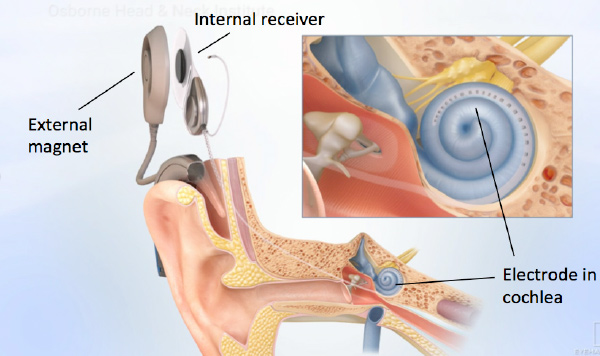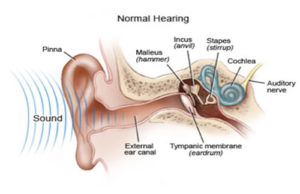- Pediatric Hearing Loss: Overview - September 19, 2016
- The Mechanism of Hearing: A General Overview - September 19, 2016
- Cochlear Implant: An Overview - September 19, 2016

- Risks of Surgery for Surfer’s Ear - October 26, 2017
- The Dangers of Untreated Exostosis / Surfer’s Ear - October 26, 2017
- Surfer’s Ear Treatment: Chisel vs Drill - October 26, 2017
A cochlear implant is an electronic medical device that serves as a functioning replacement for a damaged inner ear component called the cochlea. The cochlea is responsible for translating the mechanical force of sound into electrical signals that the brain can understand. In short the cochlea is the “translator” between sound waves and brain waves. A cochlear implant is a mechanical device that is implanted as a replacement in patients with a damaged or nonfunctional cochlea. Inner ear damage and resulting hearing loss can result from various conditions including:
- Head trauma
- Advanced age
- Physiological congenital defects
- Prolonged exposure to loud noises
- Ototoxic medication (i.e. aspirin, certain antibiotics, and chemotherapy)
- Autoimmune disease
- Ménière’s disease
- Severe ear infections
- Tumors of the inner ear and cochlear nerve (acoustic neuroma)
What does a cochlear implant procedure typically consist of?
In most cases, the procedure typically takes 3-4 hours and is performed under general anesthesia. A small incision is made in the bony region behind the ear called the mastoid. The mastoid, is partially removed with a drill (mastoidectomy). Once the round window is exposed, a small opening is made in the cochlea. The surgeon then inserts the device’s processor under the nearby muscle (temporalis) tissue. Next specialized wiring that is attached to the implant is threaded through the coiled chamber of the cochlea via a small hole (cochleostomy). The incision is then closed and the external ear is left to heal.

What can I expect after the procedure?
As is typical, there are some temporary mild side effects from general anesthesia, but the procedure is typically an outpatient procedure, allowing the patient to be able to go home on the same day. Minimal pain is to be expected, but can easily be addressed with simple medications.
Can I hear immediately after the surgery?
No, the doctor will attach the external cochlear implant pieces 3-6 weeks after the initial procedure before proceeding with fitting and programming. The incision used in this procedure typically takes approximately one week to heal.
Cochlear implant or hearing aid?
Hearing aids work optimally in cases with mild-to-moderate hearing loss. If the patient’s middle and inner ear can still transmit vibrations somewhat effectively, doctors may first prescribe a hearing aid, which serves to increase the amplitude of sound without the need of surgery. This technology incorporates intelligent software that automatically improves the clarity of speech and can do so in clamorous environments in which speech may otherwise be muddled and distorted. On the external piece there are additional settings the user can adjust to further improve digital enhancement of hearing in response to their environment.
When degenerative hearing loss becomes profound, it may exceed the point where hearing aids can be effective. The patient may hear sounds with a hearing aid, but would not be able to fully comprehend complex speech. At this point, doctors may suggest a cochlear implant, in essence acting as a surrogate outer and inner ear. The cochlear implant consists of an external piece to collect sound, a processor to convert sound to electrical signals, and an internal wired component threaded through the temporal bone and inside the coiled cochlea to stimulate the hair cells artificially. The cochlear implant can also be adjusted externally to improve hearing in different environments.
Am I a candidate for a cochlear implant?
Typically, the best course of action is to assess if a hearing aid is substantial enough to compensate for your degree of hearing loss. If your hearing loss is profound enough to exceed a point where the hearing aid is useful, then it is appropriate to proceed with discussing a cochlear implant and other surgical options. You should consult your otologist to see which is a better suited choice for your specific degree and type of hearing loss.
Issues with hearing should be promptly evaluated by a qualified medical specialist known as an otologist. Otology is a subspecialty of otolaryngology (ENT). These physicians are experts at evaluating and diagnosing conditions of hearing and balance.
To learn more about cochlear implants, please visit: www.ohni.org.



